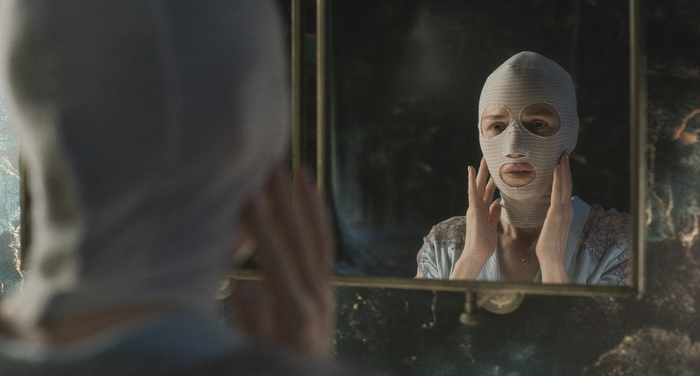Remakes, reboots, and continuations are a commonality within the horror genre. Just this year, a Texas Chainsaw Massacre film was released, which follows the first two films canonically, and the Laurie Stroud/Michael Myers saga is set to wrap up with Halloween Ends. Franchises such as Nightmare On Elm Street, The Exorcist, and Hellraiser have either received or are about to be touched by the refresh treatment. One sub-genre of this is that of foreign films being transposed for an American audience—the Ring. The Grudge, Shutter, and Pulse are some I can name off the top of my head.
With this new adaptation of Goodnight Mommy, you’re talking about a 2104 film that’s still relatively fresh in horror fans’ minds. Directors/writers Veronika Franz and Severin Fiala took audiences on an extreme journey of two twin boys who go to abnormal lengths to prove their mother has not to be replaced by an evil doppelgänger. So, what do you do? You could remake the original film shot-for-shot, maybe do a prequel, or add a bit of your flavor to a story that plays its hand of ambiguity heavily with the audience.
Director Matt Sobel elected to change the viewpoint we viewed this tale. The players are all here — Elias (Cameron Crovetti) and Lukas (Nicholas Crovetti) see their Mother (Naomi Watts) after some time goes by. However, she is covered in bandages, setting abnormal rules around the house, and forgets many customs she and her boys have grown up with. Some of the imagery remains intact from the original, but Sobel elects to peer into what emotional devastation can do to a family. There’s nothing scarier in a child’s imagination than playing up that their parent has morphed into an evil force. Sobel’s version wonders why that is and how those tremors can manifest through people who care about one another.
Slight Spoilers Ahead
Substream: One change from the original film that I noticed is one of tone. I find this version leans toward the suspense drama side. In the 2014 version, there’s a visceral, brutal turn the film takes. Here, it’s more so looking at the viewpoint of a child who doesn’t recognize a parent and how it can manifest in an internal struggle. Were there specific notes you wanted to hit with this story adaptation?
Matt Sobel: It all spun out of a central idea. For years, I’ve been interested in one specific character trait—the human tendency to need to see ourselves as the heroes are the victims of our own lives. Specifically, to avoid, at all costs, seeing ourselves as the villains. Looking into the things we’ll do, how we lie to ourselves and others, and changing our perceptions of the world. I saw in the original film an opportunity to transcribe the basic plot to fit this theme that I had been interested in since before seeing Goodnight Mommy.
The things you’re picking up on, focusing more on Elias’s psychology, all came from this central idea. It deals with Elias, his guilt, and his inability to accept it causes him to reshape the world he sees. I realized Elliott is the main character. The original film observes a family drama from some distance, but treats all the characters somewhat democratically. In our version, this is Elliott’s story. We’re watching the movie in his mind until we’re pushed violently out of it.
We work hard to make Elias quite empathic in the film’s first half. It gets you invested in his feelings of heartbreak and abandonment from his mother. When we got to the film’s second half, I felt pretty strongly that, unlike the original, if we just spent an hour getting the audience to care about this character, I don’t know if we would fear him. We would feel more of Elias’s angst and turmoil when he’s being asked to do things to somebody he doesn’t want to hurt. It naturally ended up focusing more on that sort of internal struggle of his. Who do I believe, my brother or my mom? It spilled out intuitively and organically.
The character of Mother in this version feels more like a tragic Greek character. She is chasing this beauty, but something traumatic has happened to her. It’s changed how she looks at her sons and also herself. Was it your intention to present her more in this light?
Without revealing too much, some people watched the original film and took away the notion that whatever event happened in the past caused her face to be damaged. That is not the story of the original film. There are clues in the original film which indicate that it’s not. I’ve also spoken extensively with the original filmmakers. Because their film has so much negative narrative space, it invites those kinds of conjectures.
I wanted to be more specific about this film, which is about a woman who dealt with the events of the past in a very strange way. She chose to fix her face. She dealt with a situation that was out of her control and a life spinning off its wheels by changing the one thing she could control — her appearance. I thought that’s a particular kind of person who would choose to deal with heartbreak and grief in that very unhealthy way. What else would that person do? How far would she go?
There’s a weird meeting point between her desire to be a good mother and her vanity about her fading looks, career, and her resentment toward her son. The difference between the way things used to be and the way things are — that theme is also reflected in the boys. The movie starts with remembering a happy thing from the past and arriving at a household to find a different world.
Elias draws a picture of everybody together because he’s reaching out to the past. In the same way, Mother is reaching out to the past by trying to make herself look younger. She’s trying to remind herself of a time in her life that was easier than this.
You spoke briefly about clues, and your version has its own Easter eggs. If you look at the costume design, Mother’s robe gets longer as you go through the film. Conversations between Elias and Lucas hint at things you’ll pick up on in another viewing. Keeping this in mind, was it fun to engineer these things in your way?
There are a lot of Easter eggs in the original, too. I think what was important for me is that there are some Easter eggs no one will ever notice. Those are just for us. However, there is a lot that I would like the audience to notice upon revisiting — either by remembering earlier things that happened in the film or, in your case, rewatching it.
One-sided phone calls happen where Mother is saying things that seem to mean one thing at first glance. “I don’t know how much longer I’ll have to keep pretending.” That takes on new meaning later in the story. I wanted to make sure that we tied those things together. A satisfying revelation happens when all the puzzle pieces are on the table. But, the audience has been invited to assemble them in the wrong order. It’s not very satisfying to dump a whole new set of pieces on the table and say, “now you figure it out.” That feels like you’re being manipulated. I think the thing that is satisfying is to feel like the answer was there, but I put the pieces together in the wrong order. In the end, I can finally put them together in the correct order and see that the picture was there the whole time.
Photo Credit: Amazon Studios













